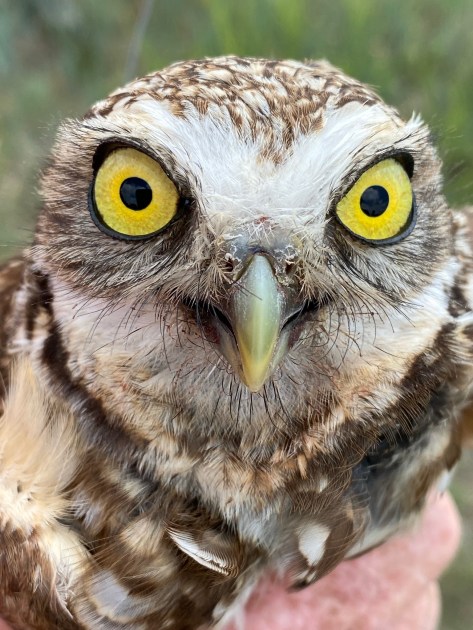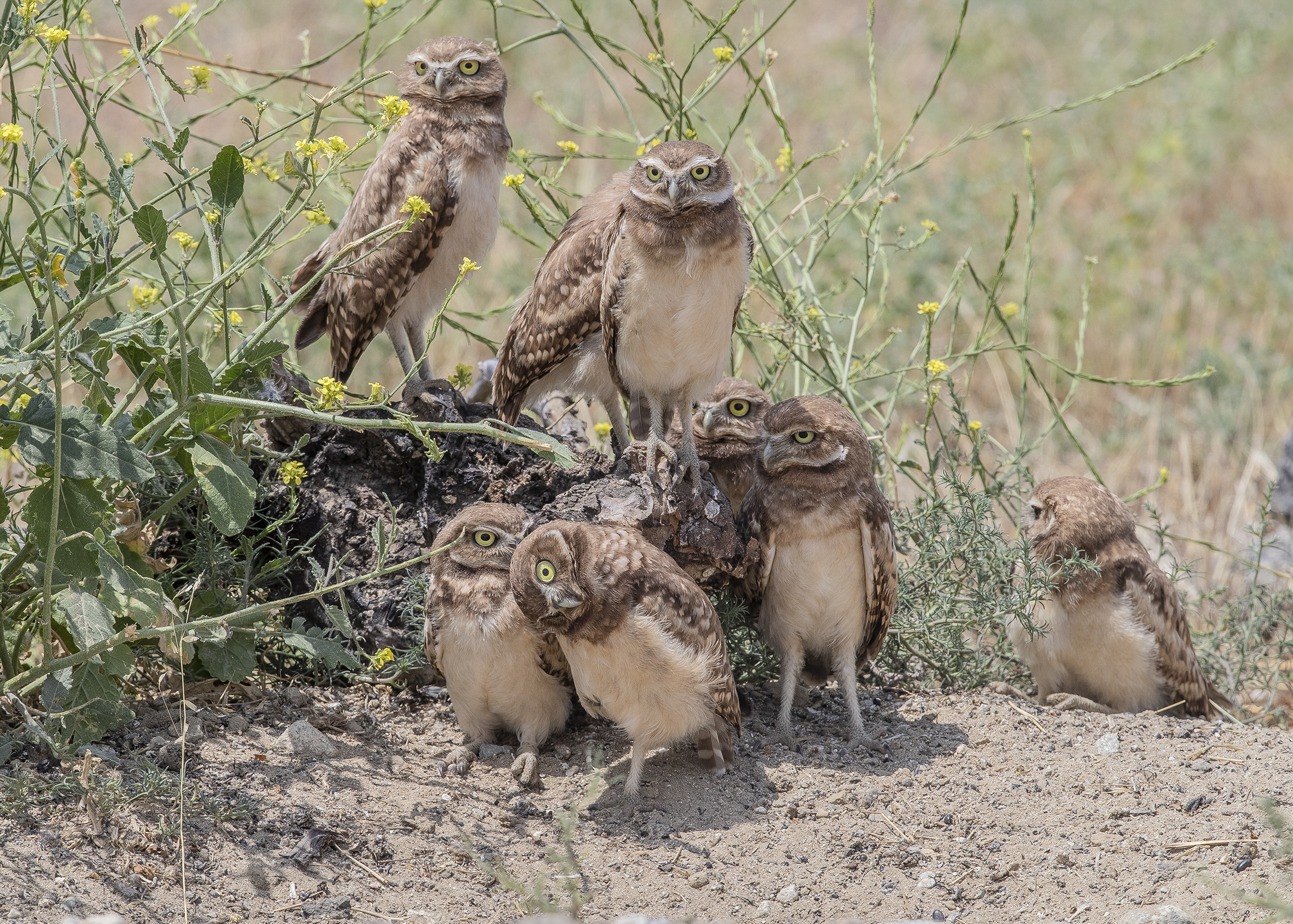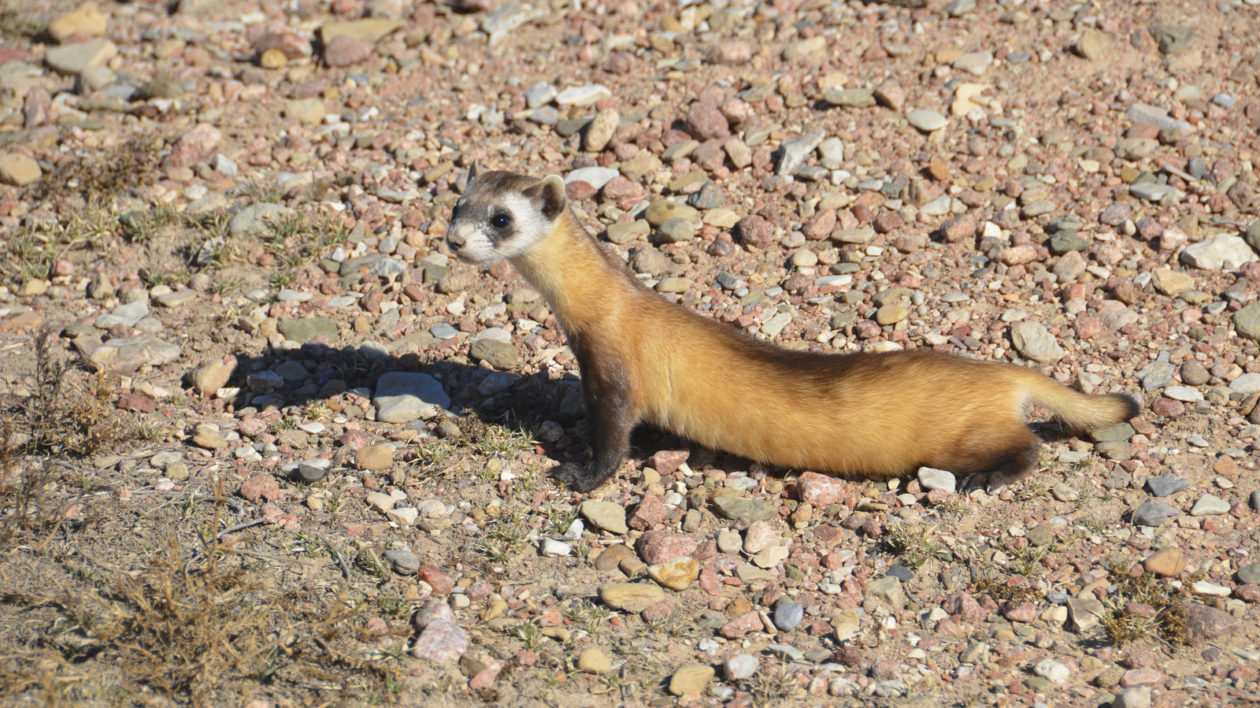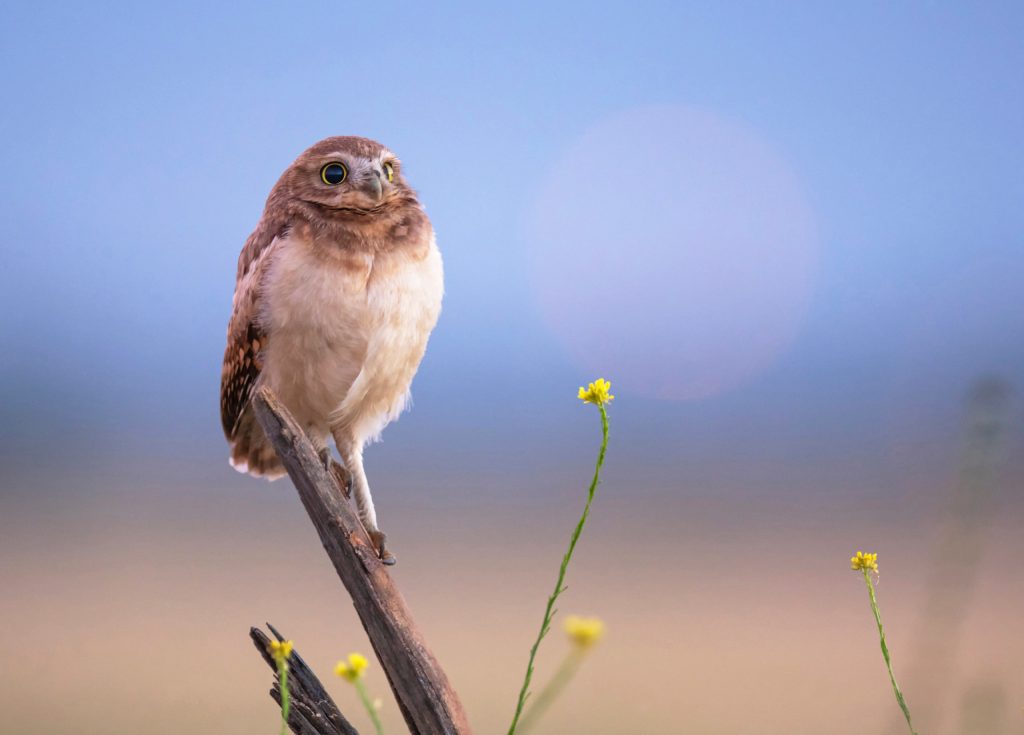Burrowing owls once ranged throughout the Great Plains and western U.S. Researchers hope tiny, solar-powered backpacks will provide information critical to a comeback.
The burrowing owl’s yellow eyes are as wide as marbles, a noticeable feature on an animal as small as a kid’s foam football.
She stays relatively still as owl researcher Courtney Conway measures her beak length and head size, weighs her and affixes a solar-powered backpack smaller than my thumb to a spot just below her head.
Then it takes less than 2 seconds for one of the country’s smallest owls to disappear down a prairie dog hole in a horse meadow outside Cheyenne, Wyoming.
You read that right. The owl flew down a hole. In a pasture.
Burrowing owls, as their names imply, live in underground tunnels created by prairie dogs, ground squirrels and other subterranean-dwelling creatures including badgers and even desert tortoises. But they’re known for their above-ground antics –the way young crowd together, hopping from hole to hole chasing beetles, grasshoppers and mice; how they tilt their heads from side to side or rotate them 270 degrees around; and how they cover the periphery of their dens with cow or horse manure.

And like many other Great Plains species, the western burrowing owls is declining, listed as species of greatest conservation need across the western U.S. and endangered in Canada.
Which is why Conway, Wyoming Game and Fish Department’s Andrea Orabona, and a revolving team of volunteers, ecologists and landowners trapped, measured and placed bird backpacks on 24 burrowing owls across Wyoming this summer.
It’s part of a broader project spanning the past eight years as Conway, director of the U.S. Geological Survey-Idaho Cooperative Fish & Wildlife Research Unit and a University of Idaho professor, seeks to understand why burrowing owls are declining, where they migrate, and what can be done to bring them back.
“They’re charismatic, so people are drawn to them. They’re fun to watch and easy to watch and stand there and do these goofy behaviors,” Conway says. “We’re unlikely to be able to save any other species if we can’t save this one.”
Borrowing A Home
Before the Great Plains were plowed, paved, and settled, grasshoppers used to hatch in clouds so thick they’d darken the skies. It was great for burrowing owls, which Conway refers to as “grasshopper specialists.”
But grasshoppers and crops don’t mix, and with aerial spraying came less food for owls. Unfortunately, an even bigger threat loomed: Prairie dog and ground squirrel eradication.
Like their fellow grassland-dweller, the black-footed ferret, burrowing owls require other creatures to make their homes in the ground.
Females and males seek out prairie dog or ground squirrel colonies with multiple tunnel options. The females lay eggs in one nest, typically about 10 feet underground, and the males stake out their own nearby hole – a bachelor pad of sorts. The male then spends his days retrieving food for his family and standing guard over the nesting hole.

After decades of research, Conway still isn’t sure if burrowing owls find abandoned tunnels to occupy, or if they kick out the furry tunnel-makers. Either way, the two creatures seem to co-exist peacefully at least above ground. In the horse pasture in southeast Wyoming, prairie dogs popped their heads up out of the ground in holes less than 10 yards from burrowing owl nests.
Where burrowing owls once occupied a range from southcentral Canada to the middle of Mexico and Oklahoma to California, so did the underground tunnel diggers.
The small mammals were poisoned, trapped, shot and exterminated from much of their native range leaving burrowing owls with fewer and fewer places to live.

Birds in Strange Places
I expect us to be way out in the prairie, somewhere miles from the nearest paved road and even more miles from a building. We’re in southeast Wyoming, after all, the least populated state in the country.
But instead we drive to a series of small horse ranches only a few miles outside the state’s capitol city.
The ranch’s owners, Eric and Erin Johnson, noticed a group of heads bouncing in their pasture last year. With binoculars, they realized it was burrowing owl chicks. Eric Johnson has noticed adult burrowing owls on his property for well over 30 years. Burrowing owl nests are easily identifiable by cow or horse manure scattered outside their den openings. The manure attracts bugs, giving the parents a little help feeding up to a dozen hungry mouths when chicks hatch.

The birds themselves are also often easy to find. Conway once identified a burrowing owl nest underneath a sidewalk by a busy gas station in Tucson, Arizona. Anywhere short grasses grow and something creates underground tunnels, burrowing owls could call home from airports and abandoned landfills to golf courses or yes, even that wide, open prairie.
Conway has been studying the birds for well over 20 years, with the birds in Cheyenne completed his eighth year trapping and tracking burrowing owls for his current project. The solar-powered backpacks running roughly $4,000 a piece tell researchers where owls are migrating and where they spend their winter.
Then if burrowing owl populations are struggling in, say, Washington, but stable in Wyoming, researchers will be able to tell if that’s a winter range issue, a transitional issue or if the problem is in Washington state itself.
While rising temperatures from climate change likely aren’t hurting the owls – the creatures live and breed in areas like California’s Salton Sea that reaches close to 120 degrees – the variable precipitation and insect populations probably are.
Too dry and burrowing owls delay breeding until far later in the season, not offering chicks as good a chance to grow before migrating. Too much rain during intense storms risks flooding burrowing owl nests.
But ultimately, burrowing owl needs aren’t all that complicated.
“Colonial small mammals can come back quickly. If you don’t till the land and transplant them they will come back,” Conway says. “Then burrowing owls can come back. There’s always the hope, more so than other birds that are declining, that their populations can be turned around.”




I love this article you need to write more for me to read.
Thank you,
Mariah Payton Rose
Another important article. In Contra Costa County California the burrowing owl population is now almost non-existent due to the eradication of ground squirrels, use of agricultural pesticides, and destruction of habitat due to development. (also affecting populations of California tiger salamanders, badgers, long-tailed weasels, and other wildlife dependant on their burrows)…ground squirrels are truly Keystone animals yet poisoning is still prevalent. Growing up in this area, burrowing owls along with so much other wildlife was commonplace…now so many of those common creatures are rare or gone. On the other hand, introduced species like turkeys, wild pigs, red-eared sliders, and starlings are all doing fine at the expense of local species.
Thank you for the article. We humans are so quick to prioritize our short-term benefits to the detriment of the long-term environmental sustainability. All those people who trapped and killed those tiny mammals never understood the impact on other wildlife such as burrowing owls. We’re all interconnected in ways that we humans have yet to comprehend.